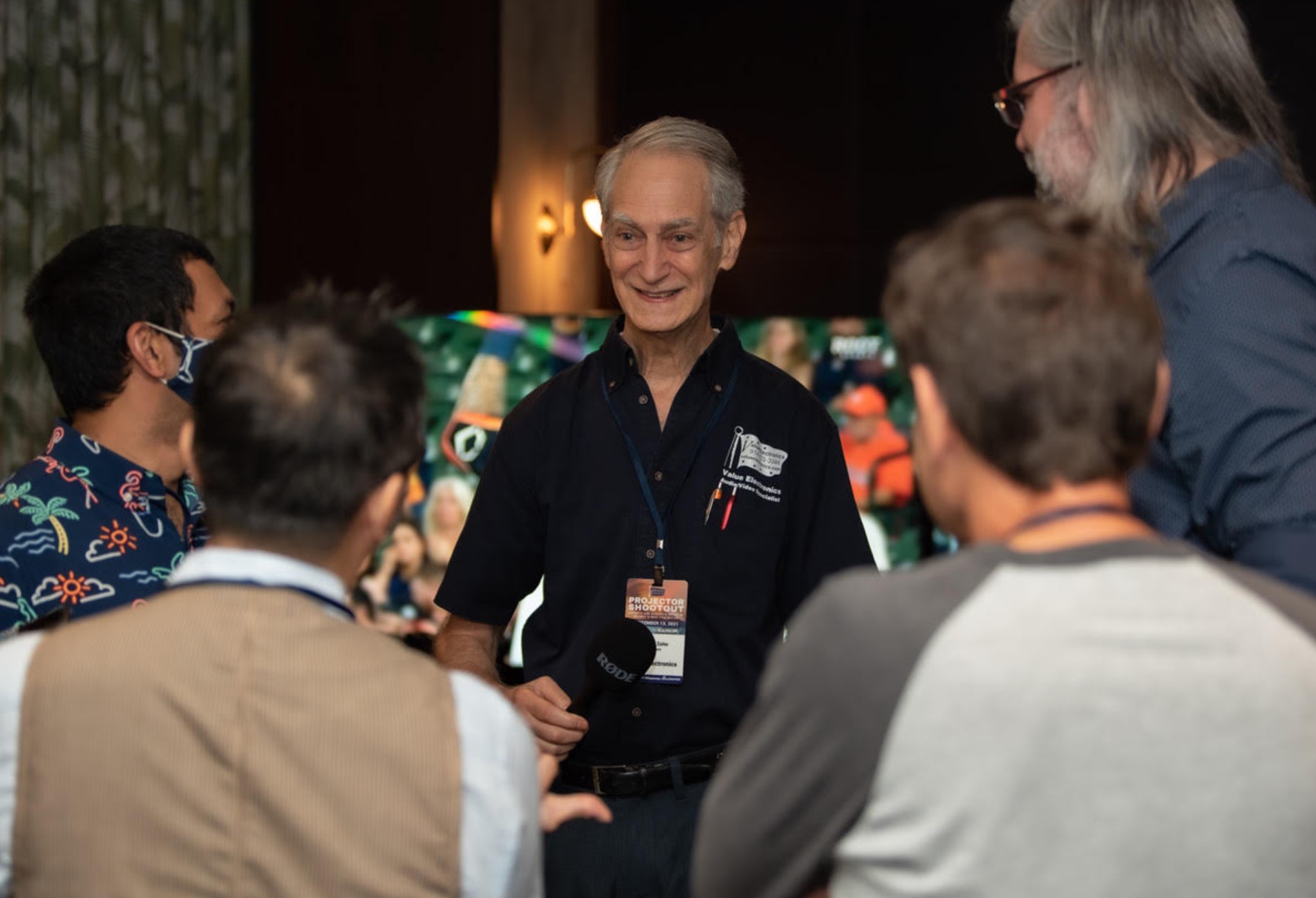Robert Zohn of VE initiated the shootout 18 years ago. In recent years, the event has compared four different premium 4K TV sets in a detailed process that has taken most of a day. This year, the program was expanded to also include three 8K sets and, on September 13th, three ultra-short-throw (UST) projectors. We will restrict ourselves to the 4K sets today.

 TV Shootout founder and organizer Robert Zohn at the 2021 shootout. (Photo: Value Electronics)
TV Shootout founder and organizer Robert Zohn at the 2021 shootout. (Photo: Value Electronics)
All of the units were taken from VE stock. Although this limits the shootout to models that VE sells, it also avoids the possibility of manufacturers providing specially selected and/or tuned units that are not typical of what consumers actually buy. In-person attendance was limited this year to allow for proper social distancing, but a moderated livestream was provided.
The sets were all calibrated by John Reformato and Jason Dustal , and signal distribution was professionally designed and installed.
The four 4K sets under test compared to the reference monitor. From left to right: Samsung miniLED-enhanced QLED LCD, LG OLED, Sony reference monitor, Sony OLED, Hisense dual cell. Luminance and color are angle-dependent so this photo should not be used to compare the sets. (Photo: Ken Werner)
The judges, all well-respected video experts, were:
- Phil Holland, Director and Cinematographer
- Charlie Anderson, Digital Imaging Technician and Director of Photography (TV only)
- David Medina, Production Technical Operations Manager, HBO
- Giles Sherwood, Director of Post Production, Criterion
- Jason Diamond, Director and Executive Producer (TV only)
- Mark Henninger, Projector Reviewer and Photographer/Videographer (UST only)
- Jason Dustal, ISF III Calibrator and Instructor & Application Engineer, Murideo
- Jeff Hagerman, Digital Imaging Technician
- David Mackenzie, Compressionist, Fidelity in Motion
- John Reformato, Engineer and ISF III Calibrator
- Channa De Silva, Techno Dad YouTube Channel owner
The four 4K sets were compared first. The sets were:
- Samsung QN65QN90A (65-inch miniLED backlight and quantum dots, $2200),
- LG OLED 65G1PUA (65-inch OLED evo with Gallery Design, $2700),
- Sony XR65A90J (65-inch Master Series OLED TV, $3799),
- Hisense 75U9DG (75-inch Dual Cell, $2999).
The protocol was to judge the sets against Sony’s 31-inch BVM-HX310 Professional Master Monitor. The 310 is based on dual-cell technology; Sony claims 1000 nits full-screen luminance and a contrast ratio of 1 million to one. Would this give Hisense an advantage since it uses the same underlying screen technology as the reference monitor? We will see.
The sets were compared in three modes: SDR with ambient illumination (“day mode”), SDR with low ambient illumination (“reference mode”), and HDR with low ambient illumination (“HDR reference mode”). A wide variety of video material and test patterns were used to evaluate motion, image quality/brightness, upscaling/sharpness, black level/shadow detail, color accuracy/skin tones, 24p motion, UHD detail/sharpness, high APL, live sports, 4000-nit tone mapping. (Clearly, some tests were not appropriate for particular models.)
I will try to summarize the results without inundating you with numbers. In the SDR day mode and SDR reference mode, the judges rated the Sony OLED best in all categories. The LG OLED wasn’t far behind except in black level/shadow detail and color accuracy/skin tones, in which the Sony was significantly better. The Hisense dual cell was worst in all categories, except that it was better than the Samsung in color accuracy/skin tones.
Comparing skin tones. From left to right: LG OLED, reference monitor, Sony OLED. (Photo: Ken Werner)
In the HDR reference mode, the Sony and LG swapped first and second places in the various categories. Notably, the Sony was much better in black level/shadow detail, UHD detail/sharpness, and high APL. The judges rated the LG moderately better than the Sony in 4000-nit tone mapping. The judge’s clear conclusion was that the Sony is, as Robert Zohn put it, the “2021 King of 4K TV.”
My View
My own impressions were largely consistent with those of the judges. I have come to expect that OLED TVs will not do well on tone mapping 4000-nit-peak images, because the peaks of the image have to be compressed so much more, with everything under the peaks compressed in such a way that tone and color gradations are preserved. They usually aren’t, but not this time The judges rated the LG highest here; I preferred the Sony. The LG’s contrast ratio suffered badly.
The Hisense was consistently the poorest performer in these tests, which surprised me. It produced noticeably less detail sharpness than the other sets and there was noticeably more motion blur. Is this an inherent problem with the more complicated optical stack, or is it just that Hisense has to learn to do a better job of implementing the design?
It’s worth saying that all four of these sets are premium efforts, and, with the possible exception of the Hisense, demanding consumers would probably be happy with any of them. But we were counting the hairs on people in the images, comparing gray-level charts, looking for details in campfires, studying the edges of the numerals on the sides of speeding race cars, and comparing face tones of people with varying ethnicities. When you spend several hours doing this, differences that at first look subtle start to look really, really big.
Neither the judges nor I figured prices into these ratings. But I’ve supplied the prices in the set list (accurate as I write this), so you can weigh them into the results as you see fit.
I always find these event valuable for recalibrating both my eyeballs and my expectations. Welcome back, Robert Zohn and the VE TV Shootout. (KW)
Ken Werner is Principal of Nutmeg Consultants. He consults for attorneys, investment analysts, and companies re-positioning themselves within the display industry or using displays in their products. He is the 2017 recipient of the Society for Information Display’s Lewis and Beatrice Winner Award. You can reach him at [email protected].

